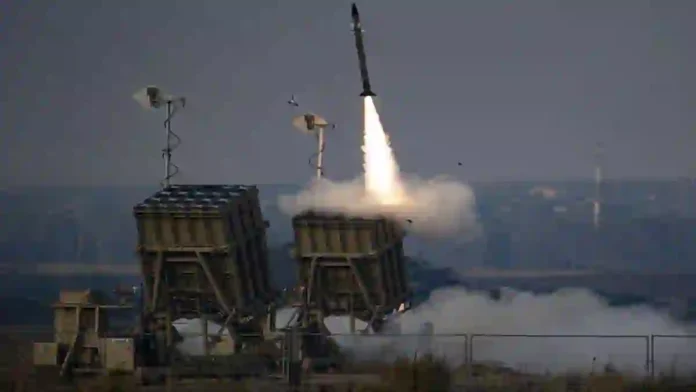Jerusalem: Iran launched its first direct military attack against Israel on Saturday. The Israeli military says Iran fired more than 100 bomb-carrying drones toward Israel. Hours later, Iran announced it had also launched much more destructive ballistic missiles.
Booms and air raid sirens sounded across Israel early Sunday after Iran launched hundreds of drones, ballistic missiles and cruise missiles in an unprecedented revenge mission that pushed the Middle East closer to a regionwide war. A military spokesman said the launches numbered more than 300 but 99% of them were intercepted.
Calling the outcome “a very significant strategic success,” Rear Adm. Daniel Hagari said Iran fired 170 drones, more than 30 cruise missiles and more than 120 ballistic missiles. Of those, several ballistic missiles reached Israeli territory, causing minor damage to an air base. Hagari said the vast majority of the intercepts came outside Israel’s borders, including 10 cruise missiles that were intercepted by warplanes.
In Washington, President Joe Biden said U.S. forces helped Israel down “nearly all” the drones and missiles and pledged to convene allies to develop a unified response.
The Iranian attack, less than two weeks after a suspected Israeli strike in Syria that killed two Iranian generals in an Iranian consular building, marked the first time Iran has launched a direct military assault on Israel, despite decades of enmity dating back to the country’s 1979 Islamic Revolution.
3-Level Defence Shield
Israel has a multi-layered air-defence network that includes systems capable of intercepting a variety of threats including long-range missiles, cruise missiles, drones and short-range rockets. However, in a massive attack involving multiple drones and missiles, the likelihood of a strike making it through is higher.
Israel uses three broad types of missile interceptors to counter the threat from Iran’s ballistic missiles, and rockets and mortars fired by Hamas, Hezbollah and other Iranian proxies
Read- U.S. URGES INDIA AND PAKISTAN TO CALM ROW OVER ALLEGED OVERSEAS ASSASSINATIONS
Iron Dome
Implemented in 2011, the Dome has saved hundreds of lives in Israel by destroying rockets launched not directly from Iran but the surrounding territories of Gaza, southern Lebanon and Syria.
The system uses radar to detect incoming rockets, shells, planes, choppers, etc, but is intelligent enough to disregard attacks that don’t pose a threat to life and property. Each interception attempt costs roughly $40,000. There are 10 Iron Dome batteries around the country with a long-term success rate of at least 90% against short-range missiles.
David’s Sling
Like the Dome, this medium-range interception system was developed by Israeli firm Rafael (not to be confused with Rafale jets made by French firm Dassault) and made operational in 2017. It can intercept heavy missiles like Zelzal-2, Fateh-110 and M-600. In 2023, it neutralised a rocket fired from the Gaza Strip.
Arrow-2 & Arrow-3
This system is relatively old, developed over a decade after Iraq fired 42 Scud missiles at Tel Aviv and Haifa in the Gulf war of 1991. Arrow 2 was operationalised in 2000 and aims to destroy long-range ballistic missiles, such as Scud and Iran’s Shahab, before they re-enter the atmosphere on their downward path. It can destroy a missile while it’s about 200km away from Israeli airspace, but is expensive, with each interceptor missile costing $3 million. Israel used Arrow 2 to destroy a surface-to-surface ballistic missile fired by Iran-backed Houthis from Yemen last Oct.
Like Arrow 2, the Arrow 3 defence system targets long-range ballistic missiles while they are still flying through space. However, it uses faster ‘hypersonic’ missiles to hit targets. It was implemented in 2017, and demonstrated its efficacy last Nov when it downed a missile fired by the Houthis.
(With Inputs From International Agency)




